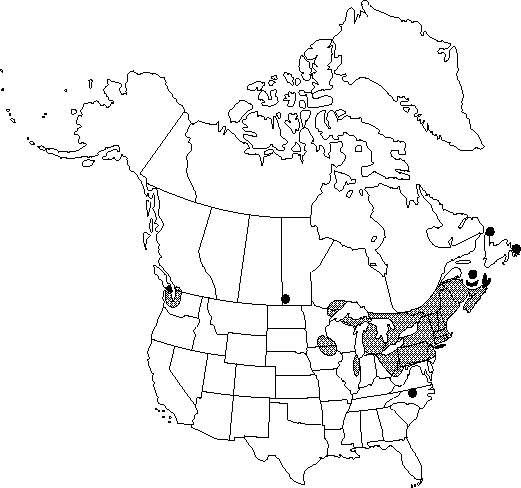Difference between revisions of "Aquilegia vulgaris"
Sp. Pl. 1: 533. 1753.
FNA>Volume Importer |
imported>Volume Importer |
||
| (7 intermediate revisions by 2 users not shown) | |||
| Line 9: | Line 9: | ||
|common_names=Ancolie vulgaire | |common_names=Ancolie vulgaire | ||
|special_status={{Treatment/ID/Special_status | |special_status={{Treatment/ID/Special_status | ||
| − | |code= | + | |code=W1 |
| − | |label= | + | |label= |
}}{{Treatment/ID/Special_status | }}{{Treatment/ID/Special_status | ||
|code=I | |code=I | ||
| Line 24: | Line 24: | ||
}}<!-- | }}<!-- | ||
| − | --><span class="statement" id="st- | + | --><span class="statement" id="st-undefined" data-properties=""><b>Stems </b>30-72 cm. <b>Basal</b> leaves 2×-ternately compound, 10-30 cm, much shorter than stems; leaflets green adaxially, to 15-47 mm, not viscid; primary petiolules 22-60 mm (leaflets not crowded), pilose or rarely glabrous. <b>Flowers</b> nodding; sepals divergent from or perpendicular to floral axis, mostly blue or purple, lance-ovate, (10-)15-25 × 8-12 mm, apex broadly acute or obtuse; petals: spurs mostly blue or purple, hooked, 14-22 mm, stout, evenly tapered from base, blades mostly blue or purple, oblong, 10-13 × 6-10 mm; stamens 9-13 mm. <b>Follicles</b> 15-25 mm; beak 7-15 mm. <b>2n</b> = 14 (Europe).</span><!-- |
-->{{Treatment/Body | -->{{Treatment/Body | ||
| Line 30: | Line 30: | ||
|habitat=Disturbed habitats | |habitat=Disturbed habitats | ||
|elevation=0-1500 m | |elevation=0-1500 m | ||
| − | |distribution=B.C.;Man.;N.B.;Nfld.;N.S.;Ont.;P.E.I.;Que.;Conn.;Ill.;Iowa;Maine;Mass.;Mich.;Minn.;N.H.;N.J.;N.Y.;N.C.;Ohio;Pa.;R.I.;Vt.;Wash.;W.Va.;native to Europe | + | |distribution=B.C.;Man.;N.B.;Nfld. and Labr. (Nfld.);N.S.;Ont.;P.E.I.;Que.;Conn.;Ill.;Iowa;Maine;Mass.;Mich.;Minn.;N.H.;N.J.;N.Y.;N.C.;Ohio;Pa.;R.I.;Vt.;Wash.;W.Va.;native to Europe. |
| − | |discussion=<p>Aquilegia vulgaris is cultivated as an ornamental and occasionally escapes into disturbed habitats. Most plants have blue or purple flowers (the wild type), but horticultural races with white or reddish flowers sometimes become established. Many cultivated columbines are derived from hybrids between A. vulgaris and related species. Some of our escaped plants are probably descended from such hybrids.</p> | + | |introduced=true |
| + | |discussion=<p><i>Aquilegia vulgaris</i> is cultivated as an ornamental and occasionally escapes into disturbed habitats. Most plants have blue or purple flowers (the wild type), but horticultural races with white or reddish flowers sometimes become established. Many cultivated columbines are derived from hybrids between <i>A. vulgaris</i> and related species. Some of our escaped plants are probably descended from such hybrids.</p> | ||
|tables= | |tables= | ||
|references= | |references= | ||
| Line 40: | Line 41: | ||
-->{{#Taxon: | -->{{#Taxon: | ||
name=Aquilegia vulgaris | name=Aquilegia vulgaris | ||
| − | |||
|authority=Linnaeus | |authority=Linnaeus | ||
|rank=species | |rank=species | ||
| Line 50: | Line 50: | ||
|habitat=Disturbed habitats | |habitat=Disturbed habitats | ||
|elevation=0-1500 m | |elevation=0-1500 m | ||
| − | |distribution=B.C.;Man.;N.B.;Nfld.;N.S.;Ont.;P.E.I.;Que.;Conn.;Ill.;Iowa;Maine;Mass.;Mich.;Minn.;N.H.;N.J.;N.Y.;N.C.;Ohio;Pa.;R.I.;Vt.;Wash.;W.Va.;native to Europe | + | |distribution=B.C.;Man.;N.B.;Nfld. and Labr. (Nfld.);N.S.;Ont.;P.E.I.;Que.;Conn.;Ill.;Iowa;Maine;Mass.;Mich.;Minn.;N.H.;N.J.;N.Y.;N.C.;Ohio;Pa.;R.I.;Vt.;Wash.;W.Va.;native to Europe. |
|introduced=true | |introduced=true | ||
|reference=None | |reference=None | ||
|publication title=Sp. Pl. | |publication title=Sp. Pl. | ||
|publication year=1753 | |publication year=1753 | ||
| − | |special status= | + | |special status=W1;Introduced |
| − | |source xml=https:// | + | |source xml=https://bitbucket.org/aafc-mbb/fna-data-curation/src/2e0870ddd59836b60bcf96646a41e87ea5a5943a/coarse_grained_fna_xml/V3/V3_242.xml |
|genus=Aquilegia | |genus=Aquilegia | ||
|species=Aquilegia vulgaris | |species=Aquilegia vulgaris | ||
| − | |||
| − | |||
| − | |||
| − | |||
| − | |||
| − | |||
| − | |||
| − | |||
| − | |||
| − | |||
| − | |||
| − | |||
| − | |||
| − | |||
| − | |||
| − | |||
| − | |||
| − | |||
| − | |||
| − | |||
| − | |||
| − | |||
| − | |||
| − | |||
| − | |||
| − | |||
| − | |||
| − | |||
| − | |||
| − | |||
}}<!-- | }}<!-- | ||
-->[[Category:Treatment]][[Category:Aquilegia]] | -->[[Category:Treatment]][[Category:Aquilegia]] | ||
Latest revision as of 22:47, 5 November 2020
Stems 30-72 cm. Basal leaves 2×-ternately compound, 10-30 cm, much shorter than stems; leaflets green adaxially, to 15-47 mm, not viscid; primary petiolules 22-60 mm (leaflets not crowded), pilose or rarely glabrous. Flowers nodding; sepals divergent from or perpendicular to floral axis, mostly blue or purple, lance-ovate, (10-)15-25 × 8-12 mm, apex broadly acute or obtuse; petals: spurs mostly blue or purple, hooked, 14-22 mm, stout, evenly tapered from base, blades mostly blue or purple, oblong, 10-13 × 6-10 mm; stamens 9-13 mm. Follicles 15-25 mm; beak 7-15 mm. 2n = 14 (Europe).
Phenology: Flowering spring–summer (May–Jul).
Habitat: Disturbed habitats
Elevation: 0-1500 m
Distribution

Introduced; B.C., Man., N.B., Nfld. and Labr. (Nfld.), N.S., Ont., P.E.I., Que., Conn., Ill., Iowa, Maine, Mass., Mich., Minn., N.H., N.J., N.Y., N.C., Ohio, Pa., R.I., Vt., Wash., W.Va., native to Europe.
Discussion
Aquilegia vulgaris is cultivated as an ornamental and occasionally escapes into disturbed habitats. Most plants have blue or purple flowers (the wild type), but horticultural races with white or reddish flowers sometimes become established. Many cultivated columbines are derived from hybrids between A. vulgaris and related species. Some of our escaped plants are probably descended from such hybrids.
Selected References
None.